
|
|

April 4, 2008
WWDJ 970/WWRV 1330, Hackensack, NJ
In this week's installment of Tower Site of the Week, we continue to dig through our archives to catch up on some of the many fascinating studio and transmitter sites in the biggest radio market in America.
That would be New York, of course, and this week we head over to see some of the stations way on the other side of the Hudson, in the radio promised land we like to call northern New Jersey. In this installment, we visit a site that dates back only 40 years, even though it's home to stations whose histories are twice that long.
On this sunny day in January 2008, we're at the end of Commerce Way in Hackensack, on the western shore of the Hackensack River, at the site that's been home to the Hackensack-licensed signal on 970 (as WJRZ and WWDJ) since 1968 and the New York-licensed signal on 1330 (as WWRV) since 1989.
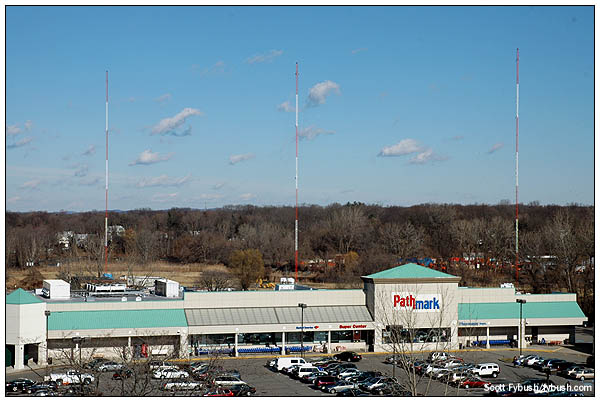
A brief history of how these two stations ended up here: The peripatetic 970 signal began its life in Jersey City back in 1920 as Frank Bremer's amateur station 2IA, which begat the station that was licensed in 1926 as WAAT. In 1941, WAAT moved to Newark, relocating its transmitter to the swamp in Kearney that was also becoming home, around the same time, to WNEW (1130) and WMCA (570). Joined by sister stations WAAT-FM (94.7) and WATV (Channel 13), WAAT became the region's first major country station before being sold in 1958, flipping to a full-service talk format as WNTA. In 1962, WNTA radio became WJRZ (as the TV station was sold again, becoming public TV WNDT), and in 1965 WJRZ returned to country.
In 1968, WJRZ uprooted itself from Newark, moving north to Hackensack as its old Kearney transmitter site was taken for construction of a spur of the New Jersey Turnpike. These three 250-foot towers went up for the station's 5000-watt signal, which would soon be sought out all over the metro area for the station's broadcasts of the Miracle Mets of 1969. Studios moved to a house on nearby Hackensack Avenue. 1971 brought new calls - WWDJ - and a new format, rock, competing head-on with the much bigger WABC. It was a valiant effort, but with FM on the rise, the days of "DJ" were numbered. It was no April Fool when the station flipped to religion on April 1, 1974, a format it's used ever since.
As for 1330, the current WWRV is a conglomeration of two share-time stations from days gone by. WEVD was the Brooklyn-based multiethnic voice of the Jewish Daily Forward, sharing the frequency first with the Jehovah's Witness station on Staten Island, WBBR, then with its post-1957 successor, religious WPOW. (There was a third piece of the share-time equation, too - WHAZ at Rensselaer Polytechnic Institute way up north in Troy also had time on 1330, but that's another story altogether.) In 1981, Salem Media bought WEVD (the Forward kept WEVD-FM on 97.9), flipping its half of 1330 to religion as WNYM. (By this point, both signals were transmitting from the old WBBR site on Staten Island.)
The share-time situation came to an end in 1984, when Salem bought out WPOW, making WNYM a full-time signal. In 1989, Salem closed down the Staten Island site, moving the station here to Hackensack (albeit still licensed to New York City), diplexing its 5000-watt signal with WWDJ's. The Salem bought the much bigger signal of WMCA, selling WNYM to the Spanish-language religious broadcaster Radio Vision Christiana, which had been leasing WNYM's airtime for several years. RVC changed the calls on 1330 to WWRV when it took over ownership of the station.
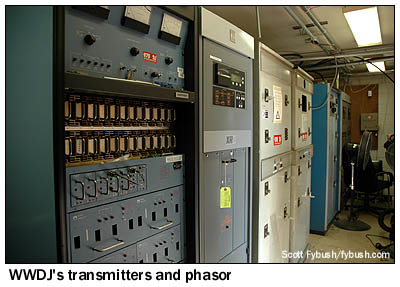
|
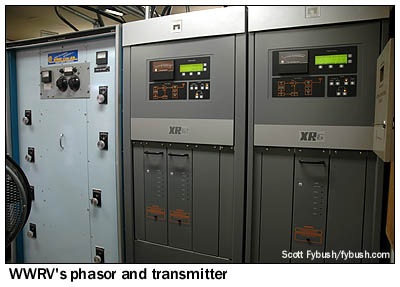
|
Salem came back into the picture here in 1994, when it bought WWDJ as a sister station to WMCA. (For a few years, it was even branding WWDJ as "970 WMCA," confusingly enough.)
In the years since, both stations have upgraded. WWRV boosted its day power to 10 kW in 2002 (still a small fraction of the power of its simulcast in the Caribbean, a 40 kW signal on 530 in the Turks and Caicos Islands that's heard across most of the eastern US at night), and when we visited, WWDJ was embarking on a major project to turn 970 into the area's newest 50 kW signal, at least during daylight hours.
To make it happen, Salem bought (and downgraded) another 970, WAMD down in Aberdeen, Maryland. While the 5 kW WWDJ signal chugged along on the Nautel XR6 transmitter (with a backup AMPFET) in the current transmitter building, right next to WWRV's Nautel XR12 and XR6 transmitters and phasor, Salem brought in a trailer next door to serve as a temporary home for a Nautel XR50 and a brand-new phasor.
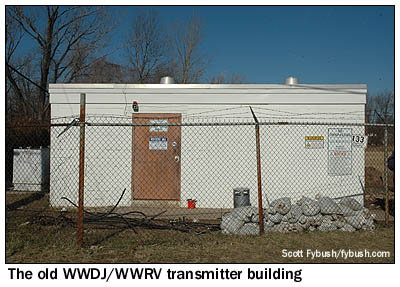
|
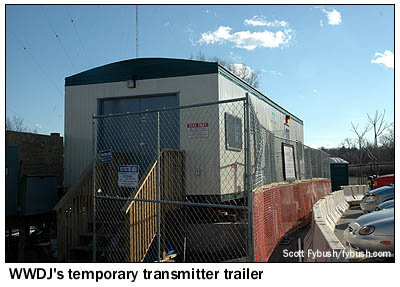
|
When we came by earlier this year, chief engineer Stu Engelke was overseeing crews that were busy installing new ATUs at the base of each of the three towers, which sport new paint jobs as well.
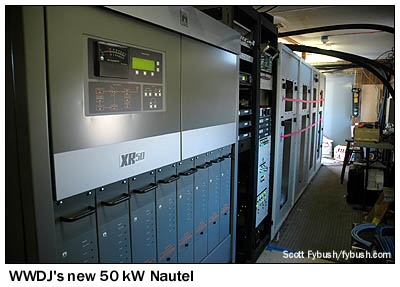
|
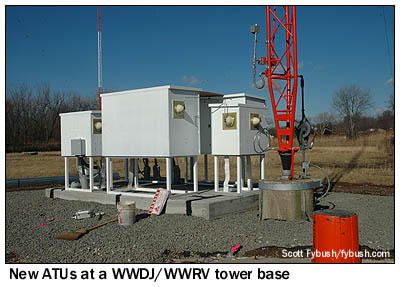
|
Once this project is finished, there will be a new transmitter building here to house WWDJ's 50 kW transmitter and phasor. WWRV will stay put in the "old" transmitter building (which isn't really all that old, having been put into use to replace the original 1968 transmitter building at the end of Commerce Way, which was later used briefly as a studio after a fire at the Hackensack Ave. house/studio, and is now being used by a landscaping company.)
It's a long way from Brooklyn, Staten Island or even Jersey City, but these stations are still going strong, serving niche communities of listeners across the region much as their predecessors have done for decades. We'll try to get back here in a year or so to see the finished upgrade!
Tower Site Calendar 2008 is almost sold out! Visit the Fybush.com Store now and get your calendar now!
- Previous Site of the Week: WFUV, New York
- Next Week: WSOU, South Orange, NJ
- Site of the Week INDEX!
- How can you help support Site of the Week? Click here!
- Submit your suggestions for a future Site of the Week!
